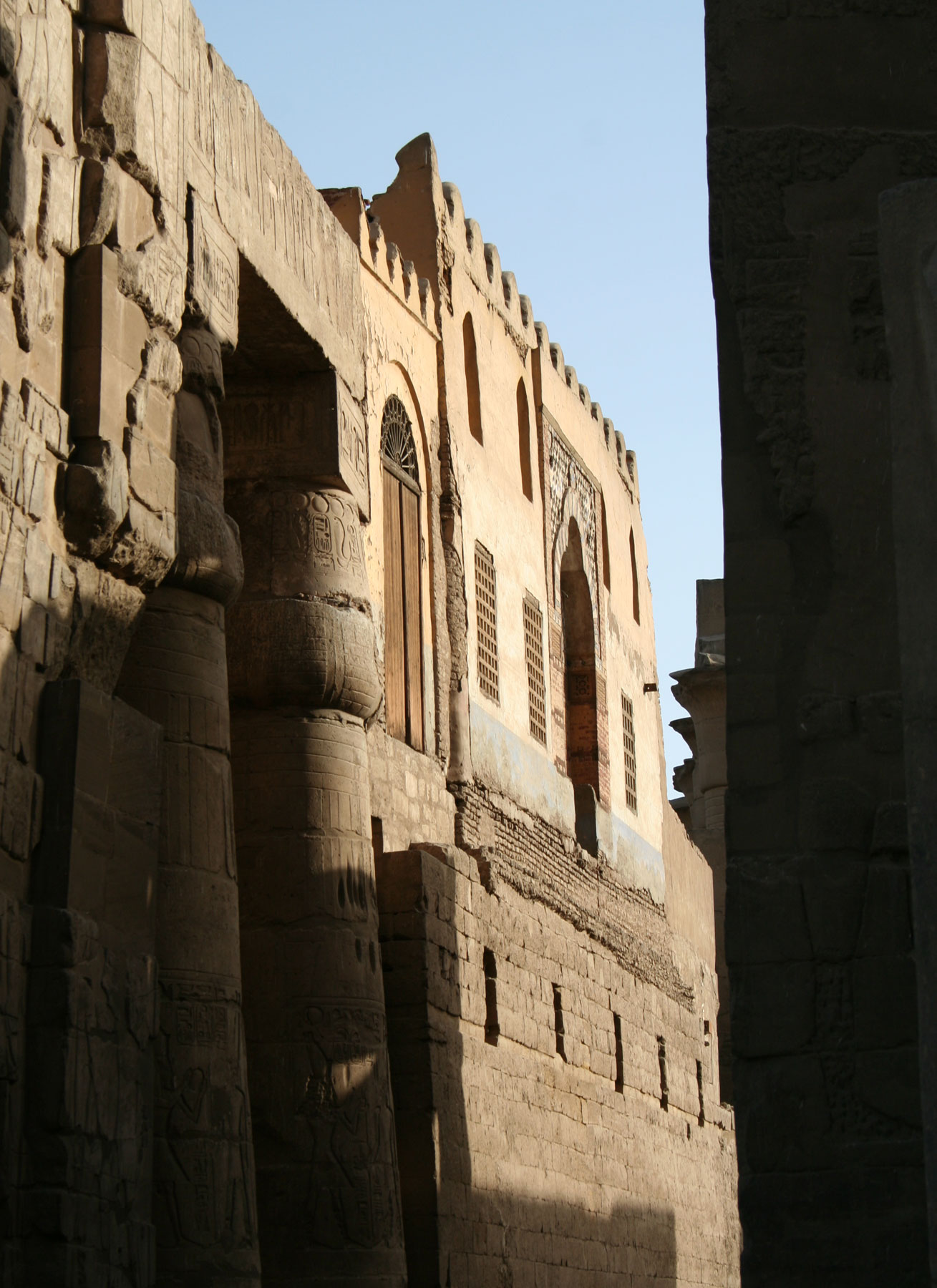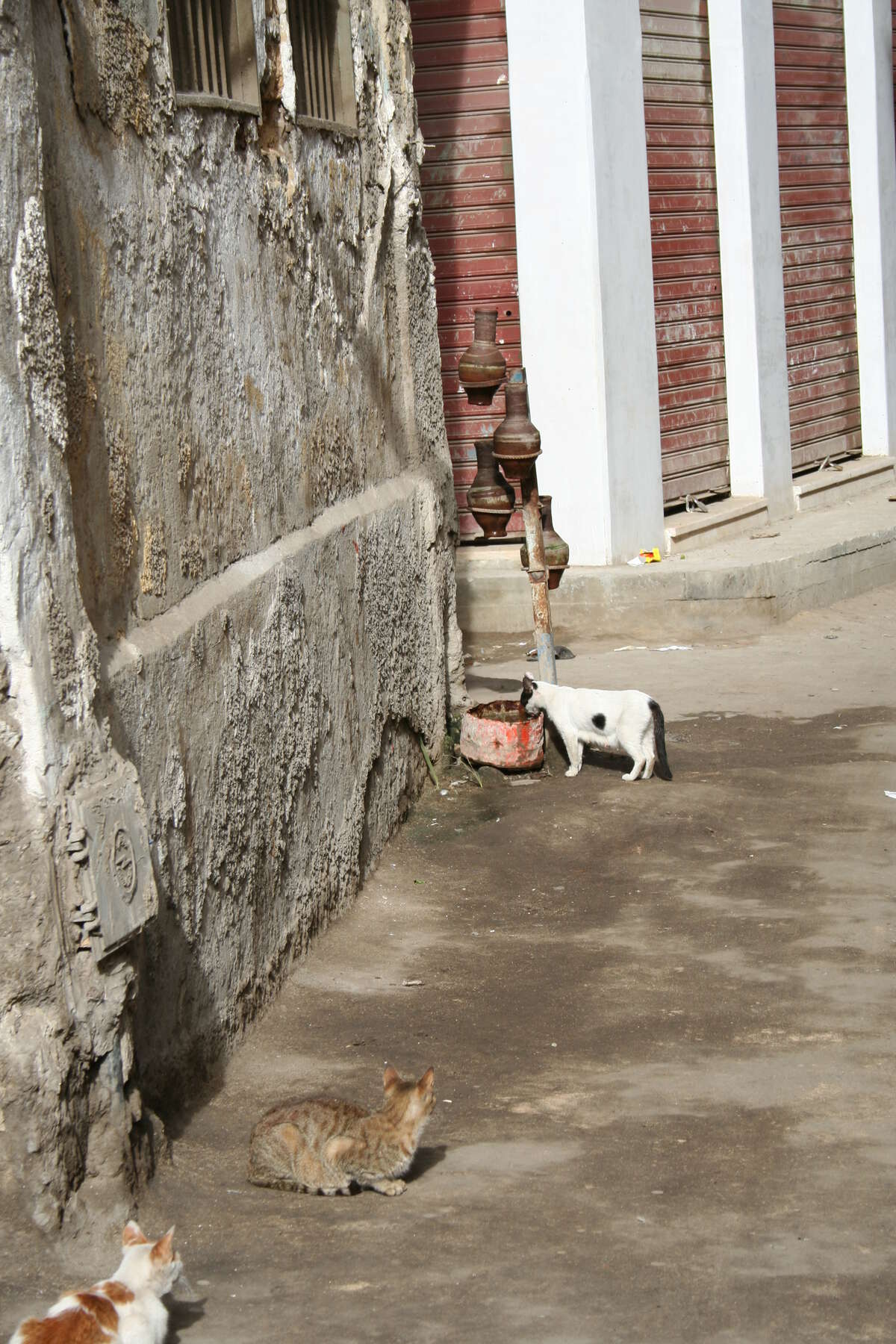9. Is Conservation of Cultural Heritage Halal? Perspectives on Heritage Values Rooted in Arabic-Islamic Traditions
- Hossam Mahdy
Why are cultural heritage conservation efforts consistently failing to win the interest and approval of conservative traditional communities outside the West, such as Arab Muslim communities? The present paper strives to investigate the causes of conflicts in attitudes and differences in values and methods between conservation professionals and Islamic perspectives in traditional Arab contexts in order to reach an understanding of how to bridge the gap for more effective and relevant conservation and management of cultural heritage.
Arabic-Islamic conservation traditions have developed over more than fourteen centuries and reached a high level of sophistication in preserving cultural heritage, with a great emphasis on intangible heritage, particularly the “word” both oral and written, including religious texts such as the Qur’an and hadith (the Prophet’s sayings), and secular texts including poetry and prose.1 However, these traditions have been marginalized and ignored by modern conservation practices, which were first introduced to the Arab region by European colonizers and Orientalists, and later adopted by Arabs and Muslims specializing in heritage-related fields. Prevailing Eurocentric theories and practices of the international conservation movement since the mid-twentieth century encouraged the continuation of separate approaches to intangible and tangible heritage, and the exclusion of Arab-Islamic traditions of conservation from approaches and methods of tangible cultural heritage. This may explain why for many decades local communities and various stakeholders were indifferent or even hostile to professionally conserved, managed, and presented cultural heritage in the Arab region.
With a few exceptions, the situation remains the same up to the present, despite shifts in conservation theory over the last two decades toward values-based conservation, the democratization of heritage practices, and the adoption of contextual notions of authenticity.
Values and Worldviews
The scope of understanding and valorizing cultural heritage by conservation professionals has been broadened by the adoption and implementation of values-based approaches, which bring professional conservation theory and practice closer to nonprofessional stakeholders and local communities. Nevertheless, conflicting attitudes are apparent in Islamic contexts. This may be explained by differences in values: “Values can be a source of conflict when one person’s or group’s ethics or views are not accepted or equally valued by other parties. Parties may give fundamentally different answers to serious ethical and moral questions” (, 31).
Conservation professionals use the concept of value “in reference to the qualities and characteristics seen in things, in particular the positive characteristics (actual and potential)” (, 7). Values as qualities departs from another common usage of the word in English: values as ethics, philosophies, or normative codes of behavior. On the other hand, from an Islamic point of view values are often defined by exactly what Randall Mason excludes from their definition within a “values-based” approach to conservation: ethics, philosophies, and normative codes of behavior. Furthermore, according to Mason’s definition and under values typologies either in use by heritage organizations or proposed, this author argues that Islamic values should be considered under social and spiritual values according to the Australia ICOMOS Charter for Places of Cultural Significance, or Burra Charter (), or as “sociocultural values,” including specifically the subcategory of spiritual/religious value, according to a provisional typology proposed by Randall Mason (, 8–10, 12).
The term “values” refers within Islamic contexts to an essentially different meaning than the same term in cultural heritage conservation norms and literature, such as the World Heritage Convention, the Burra Charter, the Nara Document on Authenticity, or the GCI research project on values in heritage conservation.2 Islamic values are not limited to religious, spiritual, or cultural aspects, as they stem from a worldview formed by Islam. According to Michelle LeBaron, “Worldviews are those systems or structures within which our values, beliefs, and assumptions lie. They influence how we see ourselves and others (identities) and how we make meaning of our lives and relationships” (, 6). Islam, as a worldview, is manifest in different fields described as “Islamic” even if not religious, such as economy, medicine, psychology, sociology, arts, architecture, and urbanism, among others. This worldview is based on Qur’anic instructions (The Qur’an 6:162).3
Besides holding an Islamic worldview, Muslims are instructed to respect various local traditions as long as they do not conflict with Islamic principles (The Qur’an 7:199). This results in diverse manifestations of Islamic cultural phenomena in different communities and cultural groups throughout the Islamic world, which share at the same time certain characteristics and qualities based on a universal ‘aqidah (belief system) and shari’ah (code of conduct). In his introduction to Architecture of the Islamic World: Its History and Social Meaning (1978), Ernst J. Grube highlights the fact that the adjective “Islamic” is not used in a religious sense: “If ‘Islamic’ is not an adjective defining a religious quality, should it be understood as a word that identifies a special kind of architecture, that of a civilization reflecting, or determined by, special qualities inherent in Islam as a cultural phenomenon?” (, 10).
For conservation professionals to limit Islam to the category of “spiritual value,” as well as their lack of awareness of Islam as a worldview, causes a conflict of attitudes. Furthermore, as decision makers and technical advisors to decision makers, they may cause irreversible damage to the intangible aspects of the very heritage they aim to preserve. “When worldviews are not in our awareness nor acknowledged, stronger parties in conflict may advertently or inadvertently try to impose their worldviews on others. Far more profound than trying to impose a particular solution to a conflict or a way of communicating, the imposition of a worldview can be destructive to a whole way of life” (, 6).
Intrinsic Values
The lack of awareness and/or acknowledgment of non-Western worldviews has resulted in the imposing of European, Christian, or secular worldviews outside of the West. This is manifest in the rationale for giving historic buildings, works of art, and cultural heritage a high or intrinsic value—a view that is held by many conservation professionals, although not all. “What distinguishes goods with especially high or intrinsic value from ordinary, everyday goods is that while we find it natural and acceptable to make trade-offs among the latter, we don’t among the former…. We are happy to allow a trade in … postcards but not the historic buildings or sublime landscapes they depict, in religious trinkets but not great religious works of art” (, 3).
Although this is an apparently modern secular attitude, it is deeply rooted in premodern Christian European values. It is extending the “sacred” within a premodern religious context into a modern secular context, while giving it the new term “intrinsic value,” which is more acceptable in a modern, secular, and international context. “When people ask whether art or liberty are sacred, often they are really asking whether these things should be highly valued, never to be compromised for the sake of something else” (, 119). By contrast, a central concept to ‘aqidah, which hugely impacts the Islamic worldview, is that nothing material is sacred, or indeed intrinsically valuable.4 Should conservation professionals fail to justify “socially constructed values” for a tangible heritage resource, their rationale would not be understood or accepted in an Islamic context, and their efforts would likely conflict with local attitudes.
Scientific values should be treated differently. Science is highly valued by Islam. It is not intrinsic, but it is more abstract and neutral than socially constructed values. However, the special place of scientific values was not relevant to cultural heritage before the establishment of archaeology as a scientific method and discipline in modern times. The importance of scientific values from an Islamic point of view is often unnoticed by conservation professionals because of the general assumption that there is a conflict between religion and science, faith and reason, or mind and soul (, xv). In other words, while the Christian West needed to limit the influence of religion in order to set the Western mind free, Muslims didn’t have to go through the same process.
Islamic perspectives on intrinsic values and the special place of scientific values explain attitudes by Saudi authorities that might otherwise seem contradictory. For instance in Makkah and Medina, a conflict between heritage values and functional values became a big issue over the last few decades as the number of the pilgrims increased every year. A decision was made to demolish a huge number of historic buildings and big areas of historic urban fabric around the holy mosques in both cities in order to build better facilities to serve the pilgrims. While many conservation professionals and organizations objected and condemned the decision, the majority of Muslims around the world fully understood and appreciated the rationale of the Saudi authorities, and in many cases praised the decision.
On the other hand, the Saudi authorities’ attitude toward the al-Hijr archaeological site is interesting, as they have been actively conserving and managing it and successfully nominated it to be listed as a World Heritage Site in 2008. Not only is al-Hijr a pre-Islamic site, but it is mentioned in the Qur’an as being built by a community that was an enemy of Allah (The Qur’an 15:80–84). The contrasting Saudi attitudes toward Makkah and Medinah on the one hand, and toward the al-Hijr archaeological site on the other, can only be understood in light of Islamic perspectives on intrinsic values and the special place of scientific values.
Assessment of Integrity and Authenticity
Integrity and authenticity are the qualifying conditions for values of cultural heritage properties in professional conservation practices. Requirements for integrity and authenticity are a crucial tool for assessing and verifying the proposed outstanding universal values of cultural properties during the nomination process for UNESCO’s World Heritage List. They are also a tool for monitoring, management, and conservation of World Heritage Sites.
However, there are many indications in the World Heritage discussions, nomination dossiers, and experts’ writings expressing concern that integrity and authenticity are culture specific, and quite confused and difficult to identify across cultures (, 22–23). In Islamic contexts, assessing integrity and authenticity as practiced by conservation professionals creates a number of problems and conflicting attitudes. The absence of ethics is a major problem. Another is the emphasis on material and tangible attributes. Also problematic is the consistent ignoring of centuries-long Islamic intellectual traditions on assessing integrity and authenticity through highly developed methods and tools.
Integrity, according to the World Heritage Convention’s Operational Guidelines, “is a measure of the wholeness and intactness of the natural and/or cultural heritage and its attributes” (, paragraph 88). This definition is the central meaning of integrity within Islamic contexts, and it excludes the meaning of integrity as “a firm adherence to a code of moral values,” which is one of the definitions in Merriam Webster’s Collegiate Dictionary. Furthermore, within an Islamic context, shari’ah is a highly developed and closely followed canonical source for methods and tools to assess the integrity of values.
The conflicting attitudes toward the integrity of heritage resources is evident throughout the Muslim world in sites that meet the World Heritage conditions for integrity, and thus are inscribed on the World Heritage List. Meanwhile, from an Islamic point of view, they do not meet the conditions of integrity. For example, the site of Ancient Thebes with its Necropolis in Luxor, Egypt, was listed as a World Heritage Site in 1979. In recent years, UNESCO objected to the Egyptian government’s project of reinstating the Avenue of Sphinxes between Luxor Temple and Karnak Temple, demolishing in its course many important buildings in the heart of the city of Luxor. The objection from UNESCO, ICOMOS, and the conservation community raised the concern that this project is stripping from the World Heritage Site some of its important historic layers in favor of the presentation of a particular historic period. Meanwhile, the suffering of affected local communities in Luxor as a consequence of this project was acknowledged and regretted by some conservation professionals and bodies. But such problems were considered to be outside the scope and mandate of cultural heritage conservation professionals and were thus left out of the discussions on the integrity of the site.
From an Islamic point of view, the integrity of the site and its values and significance cannot be divorced from moral issues. Furthermore, intangible values and human well-being are higher on the hierarchy of values and priorities of management and conservation, should they conflict with tangible heritage values.
Authenticity was defined during discussions for the Nara Document on Authenticity as a “measure of the degree to which the value of a heritage property may be understood to be truthfully, genuinely and credibly expressed by the attributes carrying the values” (, 3). Although the Nara Document offers great flexibility in understanding cultural differences and in judging values and authenticity within different contexts, the primary professional debates and practices in the field of conservation remain Eurocentric and difficult to grasp and implement in non-Western contexts (, 5).5 Furthermore, they remain essentially material based, even with the inclusion of intangible heritage, spirit, and feeling among factors contributing to authenticity (, 134).
Islamic perspectives are different in defining authenticity and the methods for its assessment. The definition of authenticity that attaches spiritual values to tangible and material attributes is not acceptable, as it is uncomfortably close to idol worship. According to ‘aqidah, the most important mission of Islam is to free humankind from idol worship so that individuals submit only to Allah, the one and only god. Hence, the dictionary meaning of Islam is “submission.”
The conflict in attitudes toward authenticity is manifest in the Saudi government’s view of the authenticity of historic buildings and sites that are associated with the Prophet. While a professional conservator would see the fabric of a historic building as an important attribute of the site’s authenticity, the Saudi authorities perceive the authenticity in the site’s location, name, and functionality. They often have intentionally demolished historic buildings and built modern structures in the same locations, with the same place names and functions, despite the outcries of conservation professionals (, 65–73). This should not be confused with the destruction of non-Islamic heritage by militant groups such as the Taliban and Da’esh (which may recall iconoclasm in a historic Christian context). This is against shari’ah and, unlike the Saudi destructions, has been condemned unanimously by scholars of shari’ah, including the Saudis.
Authentication—meaning methods and tools for assessing authenticity—is central to Islam. An elaborate and sophisticated methodology for authenticating hadith was developed and observed by Muslim scholars. This involved examining the actual text of each saying by the Prophet, as well as the chain of its narrators going back to the Prophet, with equal attention to written and oral sources. According to this methodology, a hadith is given one of six grades, which qualifies or disqualifies it as a canonical reference for shari’ah.
The body of literature on authentication within Islamic intellectual heritage is huge and highly sophisticated. It influences Muslims’ approach to history and to assessing the authenticity of sources of information for different purposes. However, the assessment of authenticity by conservation professionals within an Islamic context doesn’t acknowledge fourteen centuries of Islamic intellectual heritage on authentication. This is perhaps due to the fact that modern conservation theory and practice were initiated in the West and remain Eurocentric to a great extent, with little to no awareness or acknowledgment of non-Western intellectual achievements. This is particularly true in the case of Islam, thanks to a long Western academic tradition of Orientalism. “Clichés about how Muslims (or Mohammedans as they are still insultingly called by some Orientalists) behave are bandied about with an abandon no one would risk in talking about blacks or Jews. At best, the Muslim is a ‘native informant’ for the Orientalist” (, 105).
Waqf
Waqf is a formidable mechanism for the conservation and management of cultural heritage in Islamic contexts. The great majority of Islamic historic buildings standing today are tied to a waqf arrangement, and were not demolished or greatly altered throughout their long history thanks to shari’ah rules regarding waqf.
Waqf is an Islamic system of endowment, initiated by the Prophet as early as the first years of Islam. Like any other endowment system, waqf implies that financial resources are secured to establish a revenue-generating investment dedicated to the management, maintenance, and upkeep of an institution or building for public benefit and/or charitable causes. However, it is important to understand waqf within the Islamic worldview in order to comprehend its meaning and the way it works within a Muslim community. Muslims’ motivation to create and to respect a waqf arrangement is due to the Islamic concept of sustainable charity, meaning a charitable deed that continues to serve the community well beyond its initiator’s lifespan (, 16).
For example, a Muslim philanthropist may build a hospital within a waqf arrangement, which means also allocating resources for an investment such as agricultural lands, shops, hotels, et cetera, the revenue of which secures the management and maintenance of the hospital. Thanks to the waqf, Qalawun’s hospital in Cairo continued to function for centuries after the death of Qalawun himself, until modernization plans were implemented in mid-nineteenth-century Egypt according to a European model and in conflict with Islamic shari’ah.
According to shari’ah, a waqf deed is considered a contract with God, meaning that once the waqf document is written and registered by the judicial system, no one, not even the initiator-patron, has the legal power to make any changes (, 32). Once resources are allocated to a waqf arrangement, their ownership becomes God’s, and their management is to be overseen by the judge or the judicial system. It is this strict legal concept that gives the waqf system its efficiency and sustainability. Muslims’ respect for waqf is so great that even in times of armed conflicts, waqf arrangements are respected. For example, when the Ottomans defeated the Mamluks of Egypt in the early sixteenth century, the first decree that the Ottoman Sultan issued upon entering Cairo victoriously was that all waqf deeds were to be respected (, 341).
The waqf is a legally binding document that secures the preservation and performance of a building or institution. It is also a management plan specifying how it should be managed, maintained, and revitalized when needed. Waqf documents describe in great detail how the revenue should be spent to secure the performance of the institution and how would it function, including personnel, tools, and other relevant issues. Furthermore, a waqf document sets the criteria for appointing the administrators who should execute it under the supervision of the local legal system.
The absence of waqf from professional theory and practice in Islamic contexts today is perhaps the most damaging consequence of the lack of awareness and acknowledgment of the Islamic worldview. Despite historians’ testimonies regarding the crucial role that waqf played in the conservation and management of cultural heritage, it remained outside the domain of modern conservation debate and practices.
Sustainability and Recycling
The Islamic emphasis on sustainability and responsible management of the environment favors recycling older buildings and giving them new functions or incorporating them into newer buildings, rather than demolition and replacement, as practiced more often in modern days. Islamic perspectives on sustainability are based on the view that the aim of human life on Earth is to do good in order to please Allah. This implies human endeavors to develop the environment with care and wisdom, regardless of whether the person in question, others, or no one would benefit from such thoughtful and balanced development.6 Instructions for wise management of the environment can be found in many hadiths, such as:
Do not waste water even if performing ablution on the bank of a fast flowing large river.7
Muslims are instructed by the Qur’an to manage resources wisely:
Give to the near of kin, the needy and the destitute traveler their rights and do not squander, for the wasteful are the brothers of satan; … and do not keep your hand chained to your neck (when spending), nor open it completely, so that you will sit blamed and destitute. (The Qur’an 17:26–29)
Careful management of the environment and avoiding unnecessary waste are important aspects of Islamic attitudes to development, including urban development. For example, many architectural elements such as marble columns and wooden doors are recycled for use in new buildings. Also, buildings from previous periods are adapted partially or fully to new uses. The Mosque of Abul Hajjaj in Luxor, for instance, was built in the thirteenth century, but incorporated within its construction parts of the ancient Egyptian Luxor Temple (fig. 9.1) and (fig. 9.2).
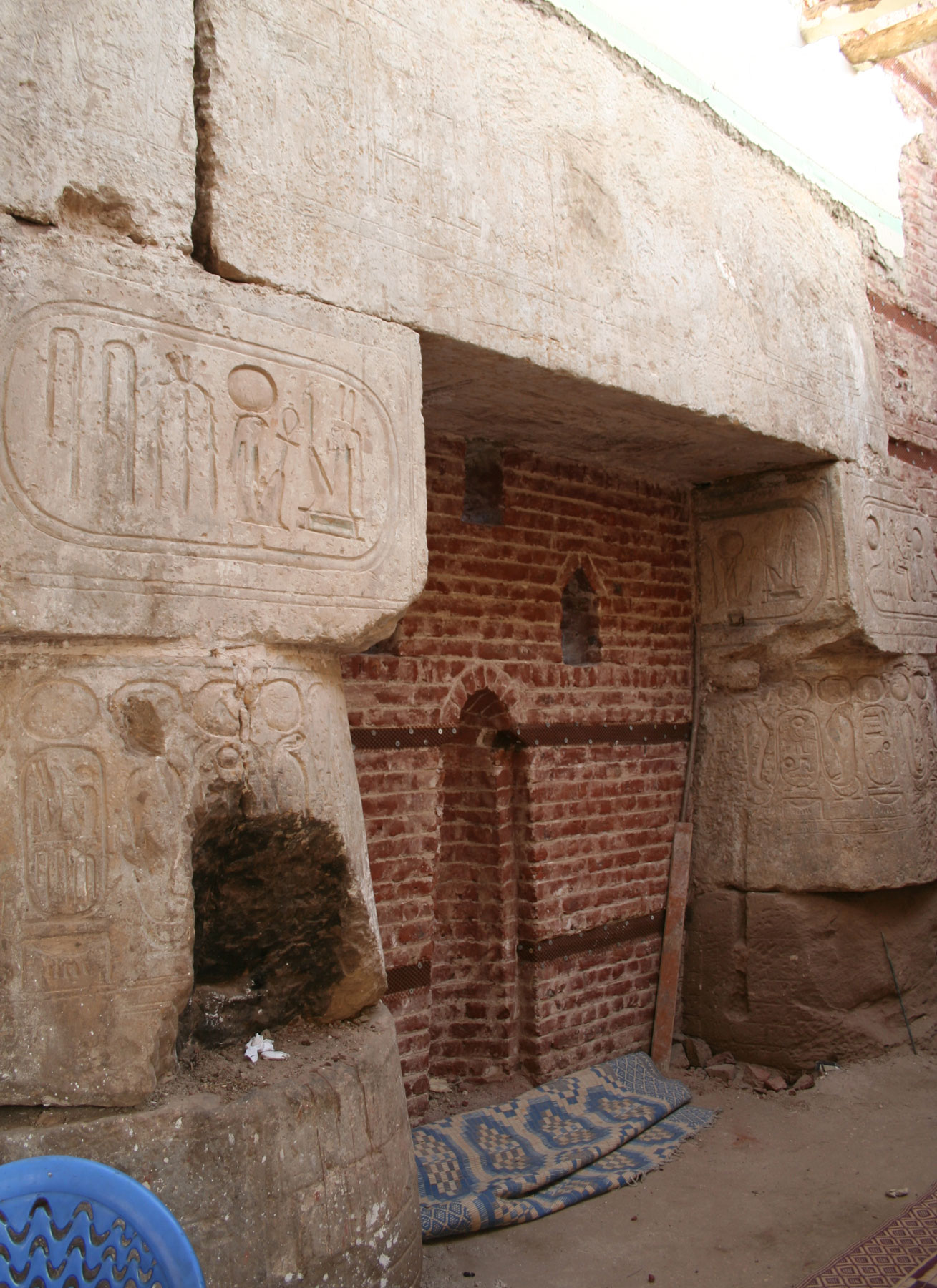 Figure 9.2
Figure 9.2Besides being a logical tool for achieving sustainability, recycling in an Islamic context should also be understood as a manifestation of Muslims’ acceptance of the cycle of life for everything, and the conviction that nothing is eternal except God (The Qur’an 55:26–27). However, a word of caution is called for. Recycling older buildings within an Islamic context was practiced in premodern times, before the establishment of archaeology as a scientific method and discipline for the understanding, verifying, and authentication of history and historical accounts. The Qur’an instructs Muslims to reflect on the material remains of previous peoples, cultures, and civilizations as “signs” or proofs, as in the verse explaining that Allah recovered the body of the Pharaoh, who was chasing Moses and the Israelites and drowned in the process:
So this day We shall deliver your (dead) body (out from the sea) that you may be a sign to those who come after you! (The Qur’an 10:92)
From the Islamic point of view, should recycling and archaeological research conflict, the utmost priority would be given to archaeology, as the importance of authenticating history is central to shari’ah, and thus supersedes other aspects and values.
Historic Mosques
Historic mosques are obvious examples of conflicting attitudes in an Islamic context. Most, if not all, premodern mosques throughout the Islamic world were tied to a waqf arrangement that secured the financial resources and management plans for maintaining them and ensuring that they functioned effectively. The establishment of Muslim-majority nation-states in modern times, following the European model, and the subsequent centralization of administration for public services meant that a government body was established to carry out the responsibility for management of all the mosques in a town, region, or country. Waqf revenue-generating investments were likewise centralized and considered a single collective pool of financial resources, to be spent according to priorities identified by bureaucrats, politicians, and decision makers, regardless of what was stated in each individual waqf document by its founder. The efficiency of management and maintenance of mosques was consequently compromised.
The identification and listing of premodern mosques as “historic buildings” meant the further compromising of their conservation, maintenance, and management, as they were divided between the ministries of culture, pertaining to conservation issues, and the ministries of awqaf (plural of waqf) and religious affairs, pertaining to religious and functional issues. The ministries of culture were modeled on European examples identifying culture as “high culture” following European mindsets (opera, classical music, theater, cinema, fine arts, and cultural heritage) that had no relevance among traditional Arab-Muslim communities. Any cultural issue related to Islam was formally considered religious rather than cultural, and was made the responsibility of the ministries of awqaf and religious affairs.
Apart from the inefficiency of management and conservation of Islamic heritage resources, this “modern” arrangement conflicts with essential shari’ah rules that forbid the spending of revenue from waqf resources on different causes than what were stated by the founders. Furthermore, according to modern arrangements, in the case of a conflict between heritage values as identified and championed by conservation professionals, and functional values as identified and championed by awqaf officials or the local community, priority is always given to heritage values. In many cases the result rendered a historic mosque less meaningful and less relevant to the local community and other stakeholders.
Conservation and management problems of historic mosques can be seen throughout the historic city of Cairo. Some grand mosques with huge capacities and facilities to house mosque-related functions, such as education, accommodation of students, and drinking fountains, lie empty and are hardly used by local communities, such as in the cases of Ibn Tulun Mosque and the mosques of Sultan Hassan and Rifa’i, which were isolated from their urban surroundings by fences and ticketing booths for the purpose of tourism. Other historic mosques in Cairo are well used but not well adapted to their users’ needs. For example lighting, ablution places, keeping of shoes, and car parking are usually dealt with in an ad-hoc manner because they fall in a blind spot between the two main responsible authorities. This manifests in many mosques in the historic city, such as Sinan Pasha Mosque (fig. 9.3).
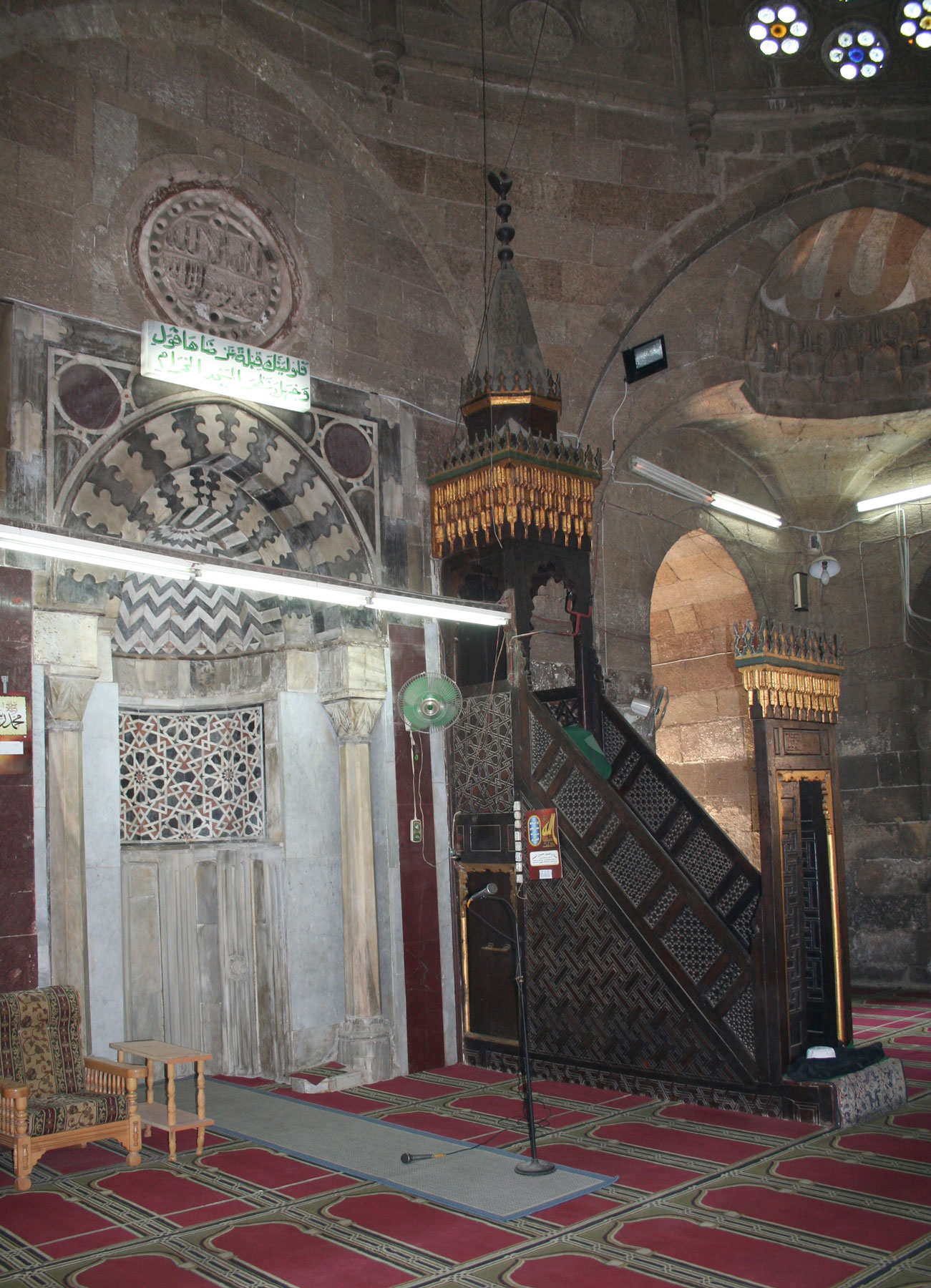 Figure 9.3
Figure 9.3Sabils
Historic sabils (drinking fountains) are an example of nonreligious historic structures in an Islamic context. In premodern Cairo many sabils were built throughout the city as acts of charity by various philanthropists to offer water to passersby. Although sabils are not religious buildings per se, they are motivated by the Islamic notion that “the best act of charity is to give water for drinking,” according to the Qur’an and hadith (, 34).
All historic sabils of Cairo were built within waqf arrangements that secured the funds and management mechanisms to permit them to function effectively. This lasted until the listing of sabils as historic structures in the late nineteenth century. Consequently, all historic sabils were transformed from charitable institutions offering the public a much-needed service to monuments without a function or meaning. The justification that was made for discontinuing the function of historic sabils was that water shouldn’t be stored or served in these fragile historic structures, lest it quicken their deterioration.
From an Islamic point of view, preventing the charitable act of offering drinking water is unacceptable. This may explain the negative attitude of local communities toward these historic sabils, even if they were adapted for new functions. The Sabil of Muhammad ‘Ali in al-Mu’izz Street is an example of this problem (fig. 9.4). Other sabils were even robbed of their architectural fixtures without much care on the part of the local community. The Sabil of Ruqayyah Dudu is an example of this problem (fig. 9.5). Historic drinking troughs for animals suffer from the same issue. An example is Sultan Qayetbay drinking trough, which was restored, closed, surrounded by a fence, and soon became a convenient point for collecting garbage for the whole street (fig. 9.6).
A clear sign that offering water for passersby is still cherished as an act of charity, and that such a service is needed today from a functional point of view, are the ad-hoc sabils that pop up in different forms and shapes in many streets in Cairo, particularly in informal areas (fig. 9.7 and fig. 9.8).
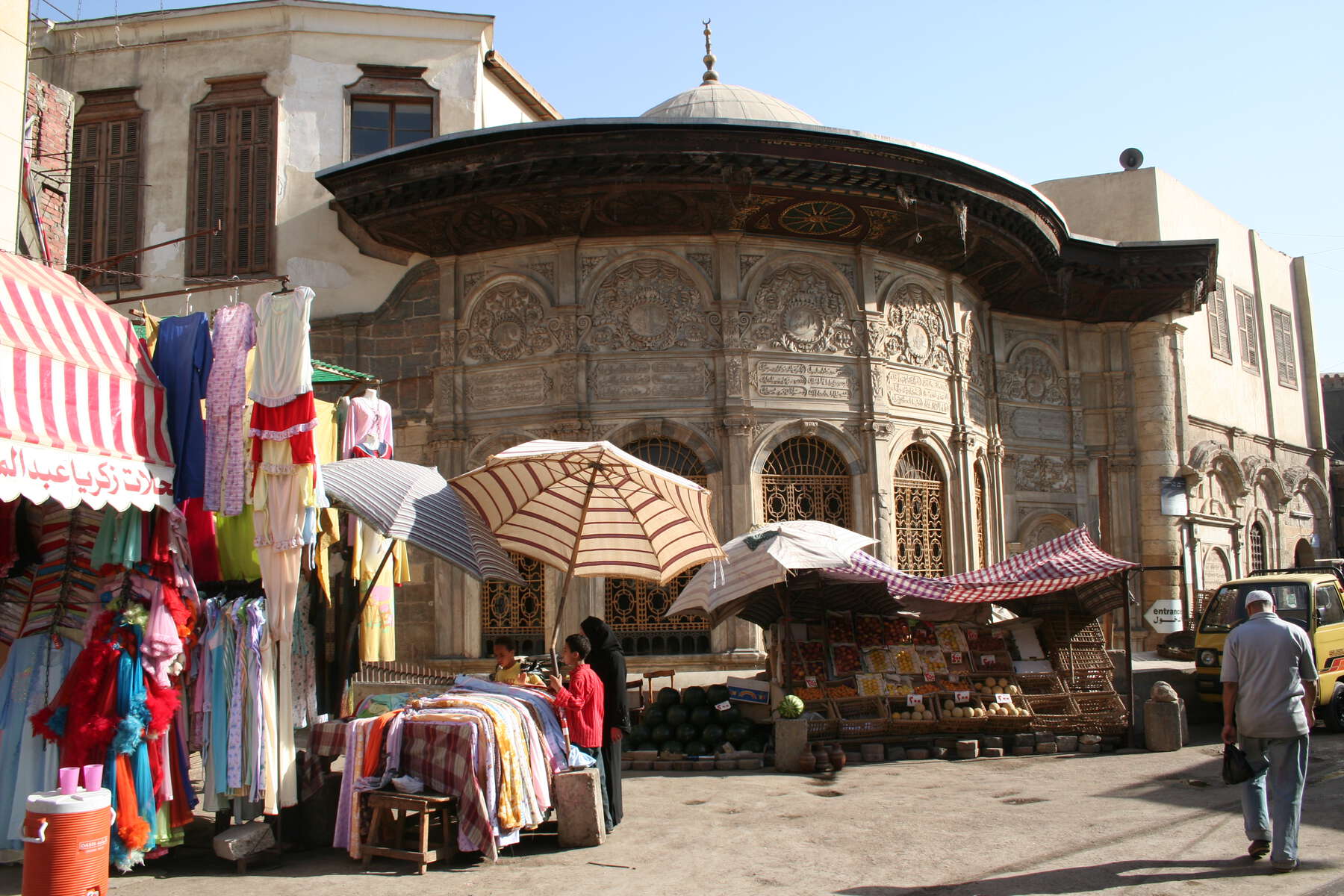 Figure 9.4
Figure 9.4 Figure 9.6
Figure 9.6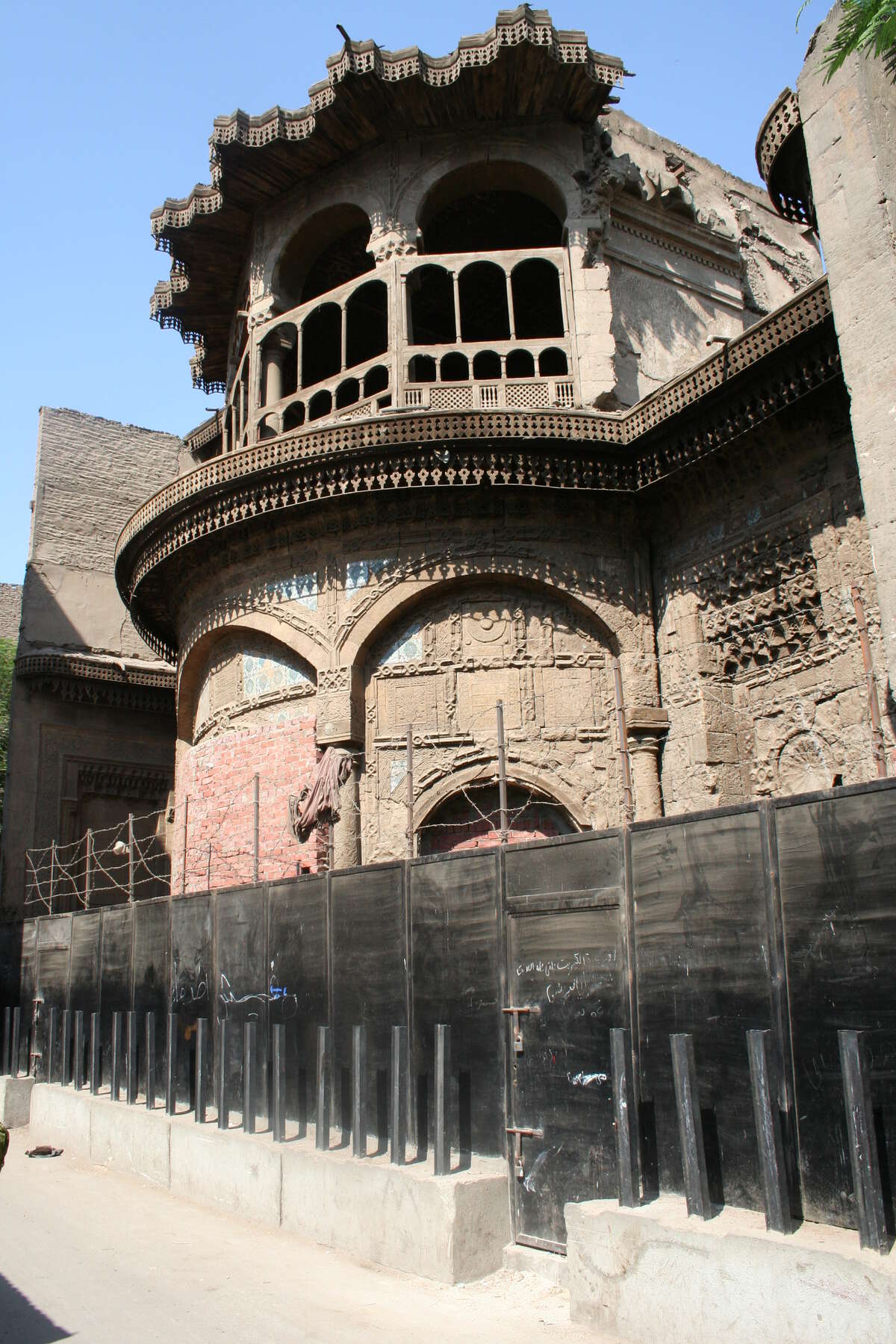 Figure 9.5
Figure 9.5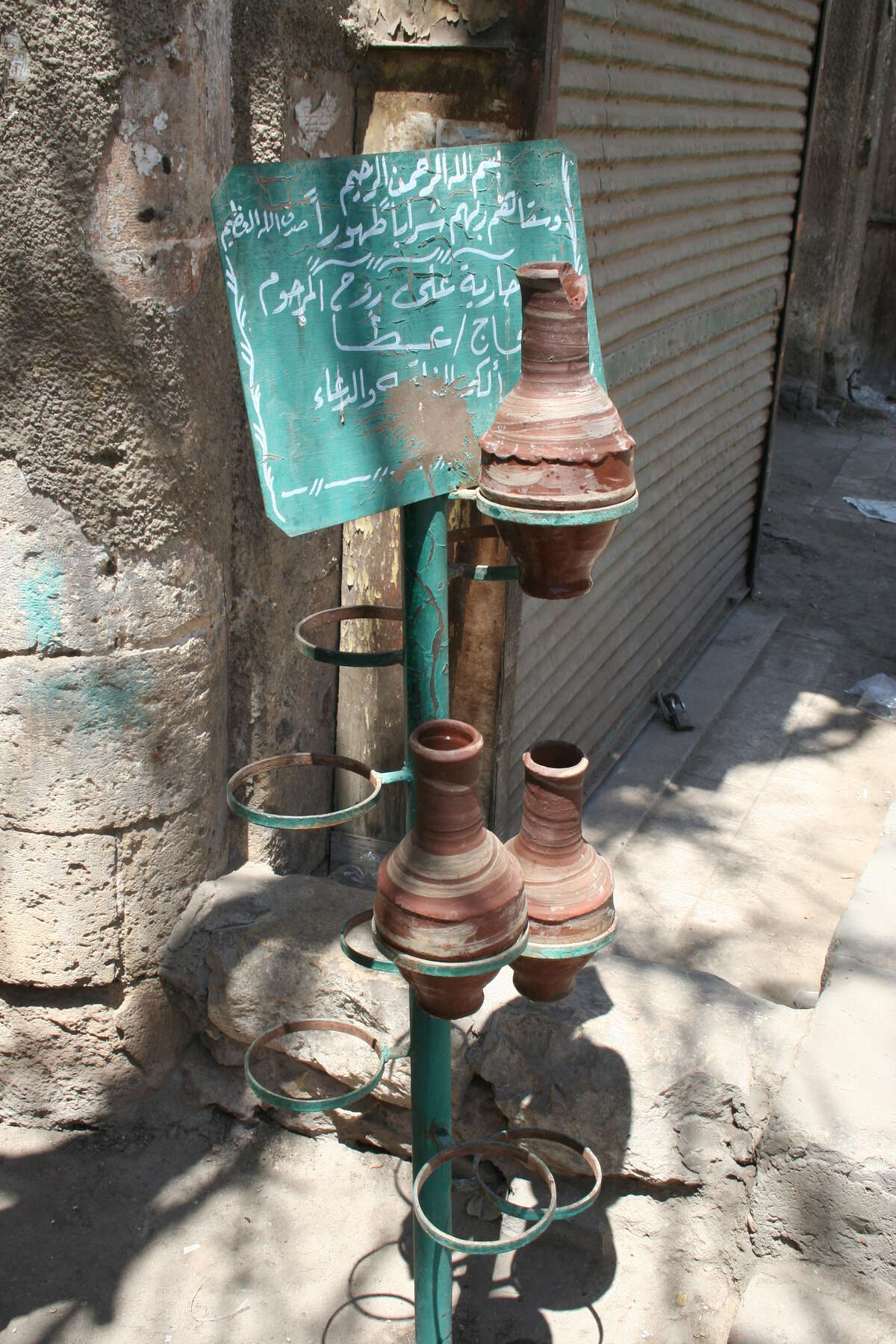 Figure 9.8
Figure 9.8Concluding Remarks and Recommendations
The identification of roots and causes for conflicting attitudes within Islamic contexts is a step toward bridging the gap between conservation professionals and local traditional communities and stakeholders. Actually, such identification is also valid as a general approach in other non-Western contexts. Differences in values may cause conflicting attitudes, and such differences should not be taken lightly, or be viewed superficially or with the assumption that they are due to carelessness or lack of education on the part of local communities and stakeholders. Investigations should dig deeply into the understanding of local cultures to find sources of differences. Should differences be due to different worldviews, consensus-building methods and tools should be applied to bridge the gap. Every effort should be made to explain relevant concepts for both “sides” in a cultural divide, including explanations of terms, concepts, and values within their cultural, social, and historical contexts.
In the Islamic context, Islam should be understood as a worldview that requires incorporation of its values and building on its beliefs in order to identify values of cultural heritage resources and assess their authenticity and integrity. From an Islamic point of view, heritage values cannot be divorced from ethics. They should not be stated as intrinsic values, nor be readily given priority over other socially constructed values. On the other hand, scientific values are highly valorized. Accordingly, archaeological values could be fully endorsed should they be adequately identified as scientific values.
Tools, mechanisms, and methods of identifying and assessing the integrity and authenticity of heritage that were developed throughout the long history of Islamic civilization should be studied, respected, and when applicable implemented, such as the waqf system. Another example is the conservation of built heritage as a means for wise and sustainable management of the environment. Accordingly, conservation and/or revitalization of built heritage are valued as environmentally friendly recycling efforts. Reconciliation should be sought between Islamic approaches, methods, and tools on the one hand, and those developed by the international conservation movement on the other. With a sensitive approach, values-based conservation concepts can be successfully applied in Islamic contexts. And the other way around may also be possible: Islamic approaches and methods may prove useful for application outside the Islamic world.
Further studies are needed on Islamic intellectual history pertaining to the conservation of cultural heritage, particularly on pre-Islamic heritage in Muslim lands, in order to avoid the hugely damaging misunderstanding that Muslims do not appreciate or care for the cultural remains of pre-Islamic civilizations.
Notes
- “Islam” in the present text refers to the civilization and worldview, not only as a religion. “Arab” refers to the culture of Arabic-speaking communities or the Arab region. “Arabic-Islamic traditions” refers to traditions based on Islam as a worldview, adopted by communities in the Arab region. However, the unique relationship between Islam and Arabic should not be underestimated. Arabic is the language of the Qur’an, hadith, and all important Islamic texts. It is also the language of prayers and other Islamic rituals. On the one hand, Arabic is the carrier of Islamic concepts. On the other hand, thanks to Islam, Arabic spread well beyond its initial abode in the Arabian Peninsula and became the first language in twenty countries and the second in more than fifty countries, and remains a vibrant living language today. This may explain why it is sometimes difficult to explain an Islamic concept in a language other than Arabic. ↩
- Stacie Nicole Smith (, 27–33) defines “values” in the dispute resolution field in a similar way to its definition within a traditional Islamic context. However, her definition has not yet impacted mainstream debates on values-based heritage management. ↩
- All Qur’anic verses cited in the present text are according to the translation by Abdullah Yusuf Ali (http://www.quran4u.com/quran_english_Yeh.htm/). The citation is indicated by chapter and verse rather than page number. The first number refers to the chapter, and the second number refers to the verse within the chapter. ↩
- Nothing material is sacred, with the exception of a few places and objects that are named as “sacred” by Islam, such as the K’abah in Makkah, the Prophet’s mosque in Medina, and the Aqsa Mosque in Jerusalem. ↩
- This remains true, as acknowledged by the first recommendation of Nara + 20, which states: “Further work is needed on methodologies for assessing this broader spectrum of cultural forms and processes, and the dynamic interrelationship between tangible and intangible heritage” (, n.p.). ↩
- The word “develop” doesn’t convey the exact meaning of the Arabic word ‘amara, which “encompasses both tangible and intangible aspects of building a place as well as revitalizing it” (, 612). ↩
- All quoted hadiths are from Search Truth website: http://www.searchtruth.com/hadith_books.php/. ↩
References
- Amin, Muhammad M. 1980. “Al-Awqaf wa Al-Hayat Al-Ijtima’iyyah fi Masr (648–923 H / 1250–1517 M. Dirasah Tarikhiyyah Watha’iqiyyah / The Waqfs and Social Life in Egypt 648–923 AH/ 1250–1517 AD (Historical-Documental Study).” Cairo: Dar Al-Nahdah Al-Arabeyyah.
- Australia ICOMOS. 2013. The Burra Charter: The Australia ICOMOS Charter for Places of Cultural Significance. Burwood: Australia ICOMOS. http://australia.icomos.org/wp-content/uploads/The-Burra-Charter-2013-Adopted-31.10.2013.pdf.
- Benn, Piers. 2004. “The Idea of the Sacred.” In Is Nothing Sacred?, edited by Ben Rogers, 119–27. London: Routledge.
- Cameron, Christina. 2009. “The Evolution of the Concept of Outstanding Universal Value.” In Conserving the Authentic: Essays in Honour of Jukka Jokilehto, edited by Nicholas Stanley-Price and Joseph King, 127–36. ICCROM Conservation Studies 10. Rome: ICCROM. https://www.iccrom.org/sites/default/files/ICCROM_ICS10_JukkaFestchrift_en.pdf.
- Freeman, Charles. 2002. The Closing of the Western Mind: The Rise of Faith and the Fall of Reason. New York: Vintage.
- Grube, Ernst J. 1978. Architecture of the Islamic World: Its History and Social Meaning. Edited by George Michael. London: Thames and Hudson.
- ICOMOS Japan. 2014. “Nara + 20: On Heritage Practices, Cultural Values, and the Concept of Authenticity.” http://www.japan-icomos.org/pdf/nara20_final_eng.pdf.
- Kamel, Omar Abdullah. 2003. La Thara’Ii’ lihadm Athaar Al-Nubuwwah [No Justification for Demolishing the Prophet’s Heritage]. Beirut: Baysan.
- LeBaron, Michelle. 2003. “Cultural and Worldview Frames.” In Beyond Intractability. Edited by Guy Burgess and Heidi Burgess. Boulder: Conflict Information Consortium, University of Colorado. Accessed March 11, 2017. http://www.beyondintractability.org/essay/cultural-frames.
- Mahdy, Hossam. 1991. “The Mosque of Mahmoud Muharram in Al-Gammaliyyah: A Conservation Study.” MSc thesis, University of Louvain.
- Mahdy, Hossam. 2015. “Proposed Arabic-Islamic Contributions to the Theory of Conservation for Cultural Heritage.” In Proceedings of ICOMOS Symposium on Heritage and Landscape as Human Values, 9 to 14 November 2014, Florence, edited by Maurizio Di Stefano, 609–13. Charenton-le-Pont, France: ICOMOS; Naples, Italy: Edizioni scientifiche italiane.
- Mason, Randall. 2002. “Assessing Values in Conservation Planning: Methodological Issues and Choices.” In Assessing the Values of Cultural Heritage: Research Report, edited by Marta de la Torre, 5–30. Los Angeles: Getty Conservation Institute. Accessed March 11, 2017. http://hdl.handle.net/10020/gci_pubs/values_cultural_heritage.
- Mostafa, Saleh Lamei. 1989. “The Cairene Sabil: Form and Meaning.” Muqarnas 6:33–42.
- Rogers, Ben, ed. 2004. “Introduction.” In Is Nothing Sacred?, 1–6. London: Routledge.
- Said, Edward. 2000. “Arabs, Islam and the Dogmas of the West.” In Orientalism: A Reader, edited by A. L. Macfie, 104–7. Cairo: American University in Cairo.
- Smith, Stacie Nicole. 2016. “Consensus Building for Cultural Heritage Place Management.” In Consensus Building, Negotiation, and Conflict Resolution for Heritage Place Management, edited by David Myers, Stacie Nicole Smith, and Gail Ostergren, 24–61. Los Angeles: Getty Conservation Institute. http://www.getty.edu/conservation/publications_resources/pdf_publications/consensus_building.html.
- Stovel, Herb. 2004. “Authenticity in Conservation Decision-Making: The World Heritage Perspective.” In “Conservation and Cultural Heritage,” special issue, Journal of Research in Architecture and Planning 3:1–8.
- Stovel, Herb. 2007. “Effective Use of Authenticity and Integrity as World Heritage Qualifying Conditions.” City and Time 2 (3): 21–36. Accessed September 26, 2017. http://www.ceci-br.org/novo/revista/docs2007/CT-2007-71.pdf.
- UNESCO [United Nations Education, Scientific, and Cultural Organization]. 2005. Operational Guidelines for the Implementation of the World Heritage Convention. Paris: UNESCO World Heritage Centre. Accessed September 26, 2017. http://whc.unesco.org/en/guidelines.
- Von Droste, Bernd, and Ulf Bertilsson. 1995. “Authenticity and World Heritage.” In Nara Conference on Authenticity in Relation to the World Heritage Convention, Nara, Japan, 1–6 November 1994: Proceedings, edited by Knut Einar Larsen, 3–15. Paris: UNESCO World Heritage Centre; Tokyo: Agency for Cultural Affairs; Rome: ICCROM; Paris: ICOMOS.
